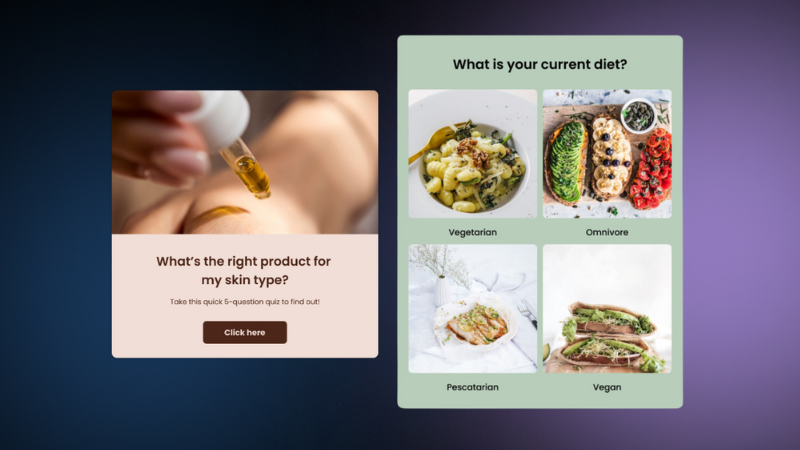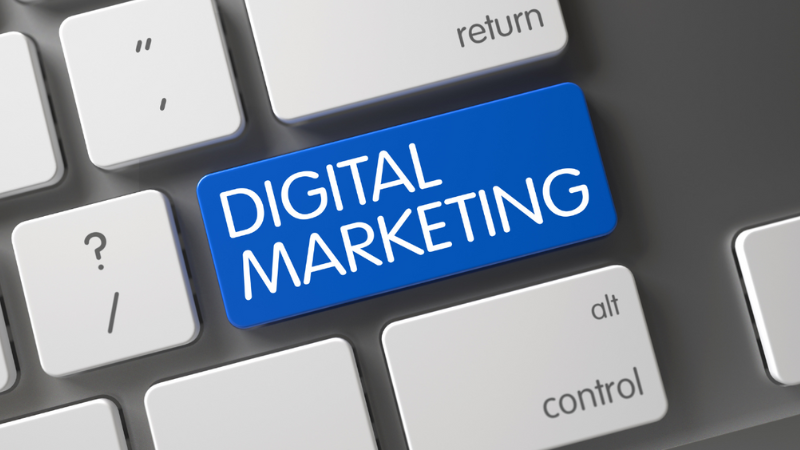17 Interactive Content Examples for Brand Growth
Marketing leaders are always looking for new ways to engage and delight their audience. Interactive web content is exactly what they need. In this article we’re going to discuss the following 17 examples of interactive content:
- Quizzes
- Polls
- Surveys
- Infographics
- Video
- Live Streaming
- Calculators
- Whitepapers
- Interactive Maps
- Dynamic Timelines
- Graphs and Charts
- Games and Gamification
- Wheel of Fortune
- Product Finders
- Countdown Timers
- Slideshows
- Interactive Forms
But before we dive in – some context.

What is Interactive Content Marketing?
Over the years, we’ve learned that inbound marketing – the kind that speaks to your customers and attracts their interest, is more appealing than outbound advertising. Sales calls and cold emails just aren’t as effective as they used to be.
However, we’re also in a world where standard inbound marketing strategies like content marketing and social media are everywhere. As a result, it’s harder for companies to turn interest into genuine engagement. That’s where interactive content comes in.
Use Interactivity to Engage Your Audience
You can easily make a survey, quiz, or poll and take your conversations with customers to the next level. This isn’t a new concept in the marketing world. BuzzFeed, one of the most popular websites in the world, creates an average of 7.8 quizzes each day to engage its audience.
However, it’s only recently that marketers have started to see how valuable this type of content can be in comparison to static content. While simple blogs and videos are easy enough to produce, they often fail to resonate in a marketplaces that’s over-saturated with information.
Interactive materials push people to get actively involved with your brand. Instead of passively reading or watching, they act, gain information, receive personalized experiences, and strengthen their connection to your company.

Interactive content marketing should be at the top of your to-do list, because:
- Klick.com says: 81% of marketers feel it grabs audience attention.
- Goo Technologies says: 82% of people ignore online ads, 73% ignore banner ads, and 62% ignore social media ads.
- The Content Marketing Institute says: 75% of companies use interactive web content to educate their audience.
Examples of Interactive Content
Any asset produced on your website to engage your audience and push them into taking action is essentially interactive. For some companies, interactive marketing will be all about designing quizzes and polls. For others, the best approach will be dynamic ads and product selection surveys.
As with most marketing campaigns, the best way to figure out which forms of content marketing tools work best for your audience is to test some different ideas.
Here are some examples to inspire you.
1. The Quiz
Quizzes are compelling because they promise us a deeper insight into ourselves. Even if the information you gain is superficial, it’s interesting. Most of us would much rather find out what kind of salad dressing we are with a personality quiz than respond to boring work emails. As marketers, quizzes are compelling because a good quiz has impressive conversion rates and can be very effective in lead generation.
Quizzes are easy to create and actively engage your audience by providing instant answers to their questions. When used effectively, an interactive quiz not only delivers valuable information but also highlights your brand’s unique personality, making the experience both informative and memorable.
Another benefit to consider is that a quiz that asks your audience to share information about their thoughts, feelings, and personality helps you get to know them better. It’s a great way to entertain your customers while showing thought leadership. It’s also an excellent way to consensually collect useful information about them. And, if you make it exciting enough, it has a high potential of being shared across verious social media platforms.
There are many different kinds of quizzes, such as:
- Personality quizzes: E.g. “Are you more of a Summer, Winter, Spring or Fall Person?”
- Diagnostic quizzes: E.g. “Do you have the common symptoms of diabetes?”
- Trivia quizzes: E.g. “How much do you really know about the history of phones?”
Just remember that it’s more than writing a series of questions, it’s creating a journey. So, you should make a quiz that is inviting and engaging. One that takes your audience on a colorful journey. By doing so you will make your viewer an active participant, and maybe even a brand advocate.
Here’s a live example. Try it out:
2. Polls
Among the many types of content available, polls are a great way to simultaneously capture audience attention and increase your knowledge of your audience. A poll is good for top-of-the-funnel marketing. That’s when your audience is in the awareness stage, looking for options and solutions to their problems.
With a product poll, you ask your audience to consider what the best solution to their problem might be. For example, you can use our poll maker to create a poll that asks Facebook followers whether they would rather have a DIY app for accounting or a professional person-to-person service that guides them through the process.
You can also tap polls to generate ideas for new or updated product lines. A fashion company might ask its customers what colors they like best, or which trends are most appealing to them right now. The great thing about polls is that they don’t require much effort from your audience (or from you). If your customers aren’t invested enough in your brand for a full quiz, a poll requires just one click of a button.
There are many types of questions you can use in your poll. Here are a few examples:
- Multiple choice: E.g., “How do you prefer to drink your coffee? (a) Black (b) With milk (c) With a milk substitute (d) I don’t drink coffee
- Rating scale: E.g., “On a scale of 1-5, how do you feel about working from home? (1=I hate it, 5=I love it)”
- This or that: E.g., “Takeaway or home-cooked meal? ”

3. Surveys
Surveys are similar to polls because they ask for your audience’s thoughts and opinions. However, with polls, you generally focus on one question.
With a survey, you ask a number of questions to get to deeper, more valuable information. For instance, a survey about your customer service strategy might ask your audience:
- How long did you wait for a customer service rep?
- Would you use our service again, or recommend it to others?
- What did you like about your interaction?
- What would you like us to do differently?
- How would you rate our efficiency on a scale of 1 to 5?
Using a survey maker makes it easy to build an engaging interactive survey that can help you communicate with your audience.
If you’re experimenting with this format of content for the first time, avoid asking too many questions in your surveys straight away. This might scare customers off. In addition, make sure your questions are clear and consider adding images or other visual content. It’s inviting and encourages respondents to continue.
Try out this interactive survey:
4. Interactive Infographics
Xerox found that 65% of brands use infographics in their content marketing.
Infographics are brilliant for building brand awareness because they deliver plenty of valuable information in an easy-to-consume format. They provide a colorful fountain of data, often organized into bite-sized chunks.
Static infographics are great, but you can take them to the next level by making them an interactive experience. A little bit of coding is all it takes to create a page that unfolds as your customer clicks on pieces of information.
You could even create an Infographic like this Padio.com infographic. It shows you the daily routine of famous creative people and lets you filter their schedules according to your interest.
Interactive infographics like this are great because they allow users to control the information they get. This means that you can create something that appeals to various segments of your audience, without forcing each client to scour through tons of irrelevant information.
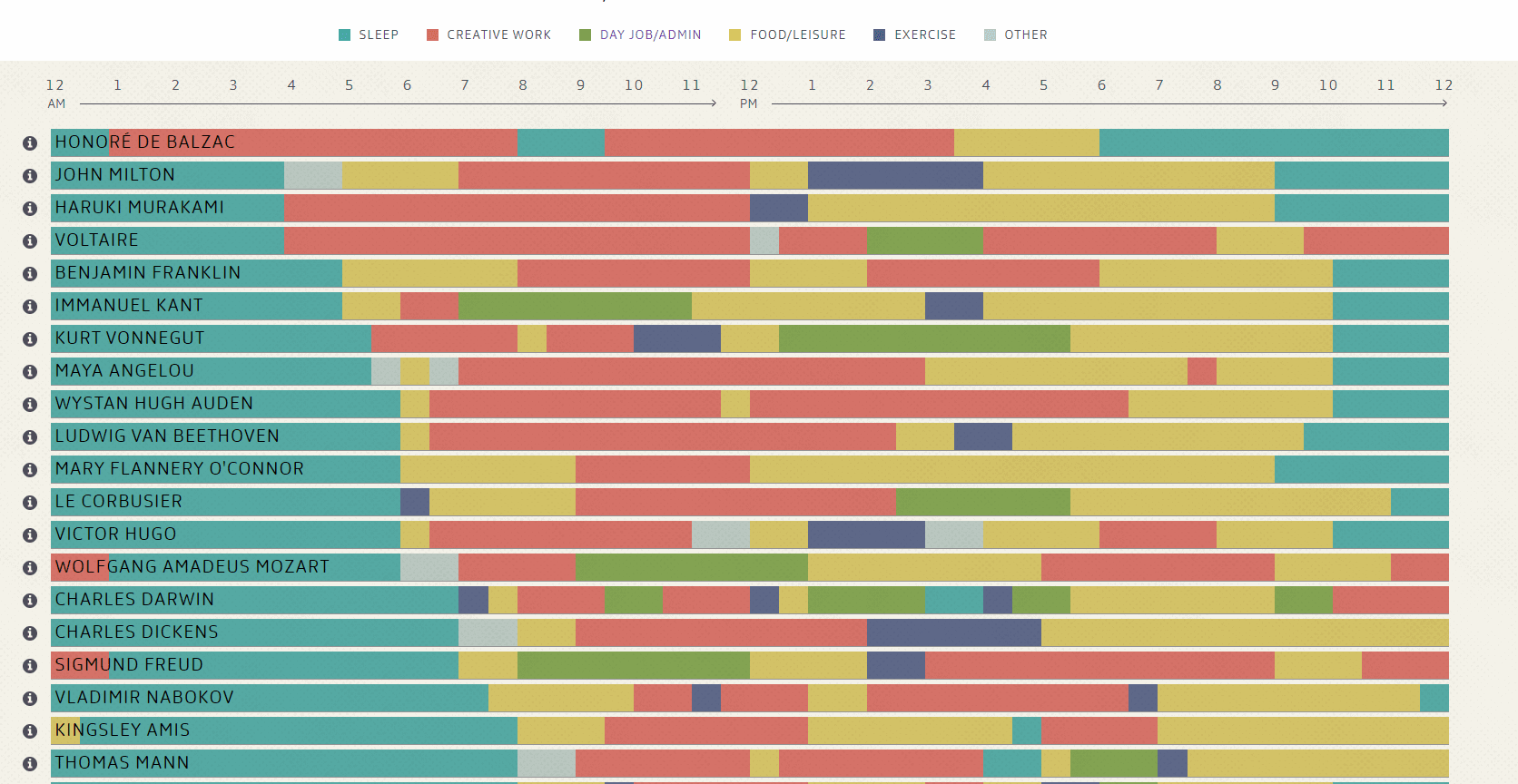
5. Interactive Video: AR & 360 Degree Videos
You could argue that video is inherently interactive. We engage with video by clicking a button for it to play and listening to or watching the information presented.
As technology and websites continue to evolve, we now have new ways of making videos even more interactive. For instance, you can create interactive video content that allows visitors to click on different elements as they go through the clip, directing their own educational experience.
With 360-degree video, you can invite customers to step into a different environment and explore it with their smartphone. As you move your device, your perspective changes, giving you a more complete view. If you’re watching from a stationary screen you can move the video image with your mouse. Check out this eye-opening National Geographic 360 video, for instance:
People are becoming more comfortable with interactive video these days as it begins to appear on channels like Facebook and Instagram. You can even build your own AR video experiences into apps and pre-existing tools like Snapchat. Gucci, for example, invites customers to try on new shoes with AR.
6. Live Streaming
This is another example of how you can make your videos more interactive. Usually, when you use video in marketing, you produce something like a product demo or “How to” video and post it on social media. Your customers then have the freedom to interact with your piece of content whenever they choose.
Live streaming takes a different approach. It asks your clients to connect with you at a specific time, on a certain platform. And it works. 80% of people would rather watch a live video than read a blog. And 45% of them say they’d even pay for exclusive live streaming from their favorites.
As you stream your fresh content, customers can ask you questions, react to what you’re saying with emojis, and more. Live streaming is as close as you can get to having a face-to-face conversation with your audience when you’re millions of miles away.
7. Interactive Calculators
Another excellent example of interactive marketing tools is the online calculator or measurement tool. Based on the simple calculator we all know, it provides a valuable source of entertainment and information for customers. Like the interactive quiz, the interactive calculator offers immediate feedback. It addresses your consumer and their need for instant gratification.
Over the years, companies have created everything from headline analyzers to savings calculators, salary checkers, and unit converters. All participants need to do is input their email and some basic information. The calculator sorts through the information and delivers an automatic response. It’s a win-win situation, users receive the information they need and brands receive qualified contact info. Many private banking and investment companies use financial calculators to attract potential clients and start a conversation with them. But some marketing wizards take this excellent tool to the next level.
The Hubspot Website Grader regularly shows up among industry-leading interactive marketing examples. This in-browser app asks you to enter your email and website address. In return, Hubspot calculates the quality of your site based on plenty of informative metrics and resources to give a score.

The great thing about calculators is that they come with a selling opportunity tied in. If a customer discovers that they don’t have a good website, for instance, or that they don’t show up well on search engines, Hubspot can sell them services to improve their quality score. And they trust Hubspot enough to know that a better score will probably influence the important stuff, i.e. increase site views and conversions.
Even if your prospects don’t need anything from you immediately, you get their email address to nurture them towards a conversion later.
8. Dynamic Whitepapers
Whitepapers demonstrate your authority in your field and help to build a rapport with your clients. Instead of pushing a particular service or product, you can use whitepapers to deliver insights on an important topic. In a standard whitepaper, the most interactive activity is skipping from one page to the next. However, a whitepaper can be a powerful form of interactive personalized content (when used correctly).
You can use animations and infographics to make the experience more immersive. You might add a visual timeline to your whitepaper, or a quiz halfway through. Look at this dynamic whitepaper from NetApp.

The interactive elements of the design give you different ways to click through the information, keeping the user active and interested while reading. Combining different types of quality content, like videos, infographics, and dynamic timelines further engages the reader along the way.
9. Interactive Maps
If you’re sharing data from a range of geographical locations, your audience will only want to see the information that’s most relevant to them. Rather than making your customers scroll through a long infographic to find the information that’s suitable to them, try a dynamic map instead.
Vibrant Doors uses an eyecatching dynamic map as the entrance gate to a rich interactive experience of interior design trends around the world. A click on the map will lead you to another interactive page about design trends in the country you chose. It’s quite enchanting, don’t you think?
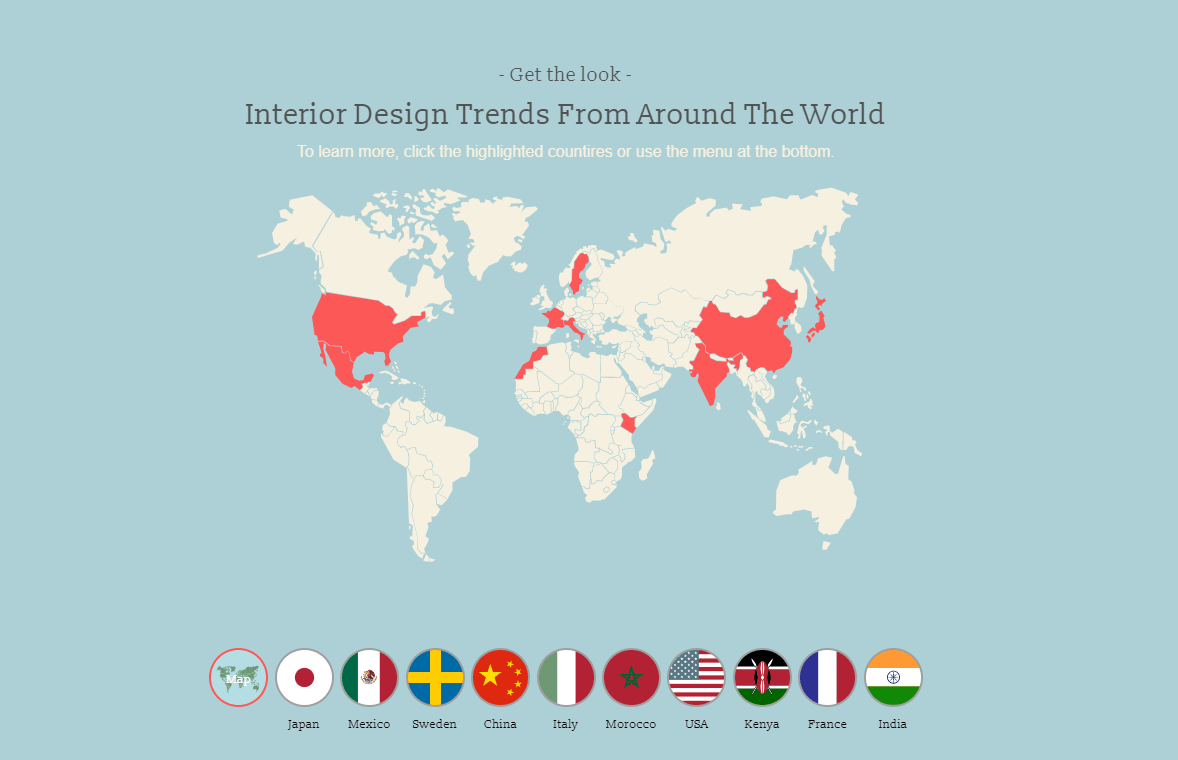
The functionality of your interactive map will depend on different factors, including what you can give your customers in various locations. For example, if you have physical stores set-up in countries around the world, you might provide addresses and directions when someone clicks on a certain portion of your map. If you want to show where your company is making an impact, you can design a map that links to case studies of your work in each region.
10. Dynamic Timelines
Timelines are one of the most popular types of infographics. They provide useful data based on specific points in history. For this reason, they are a great way to offer an insight into your company’s growth.
So, if you’re trying to develop credibility as a growing company, a timeline shows your customers how far you’ve come. The use of a timeline also shows that you know how to do your research and present it. Compiling information into an organized and orderly set of points in time makes your business seem professional and well-read.
Interactive timelines are compelling because they give customers a way to click around and explore points in history. There’s no demand to read the information in a linear fashion. This can increase both time-on-page and click-through-rate.
In this timeline, Akita, a UK-based IT support company, uses an interactive timeline as an engaging thought leadership tool. Their timeline offers a visual representation of the history of computing.
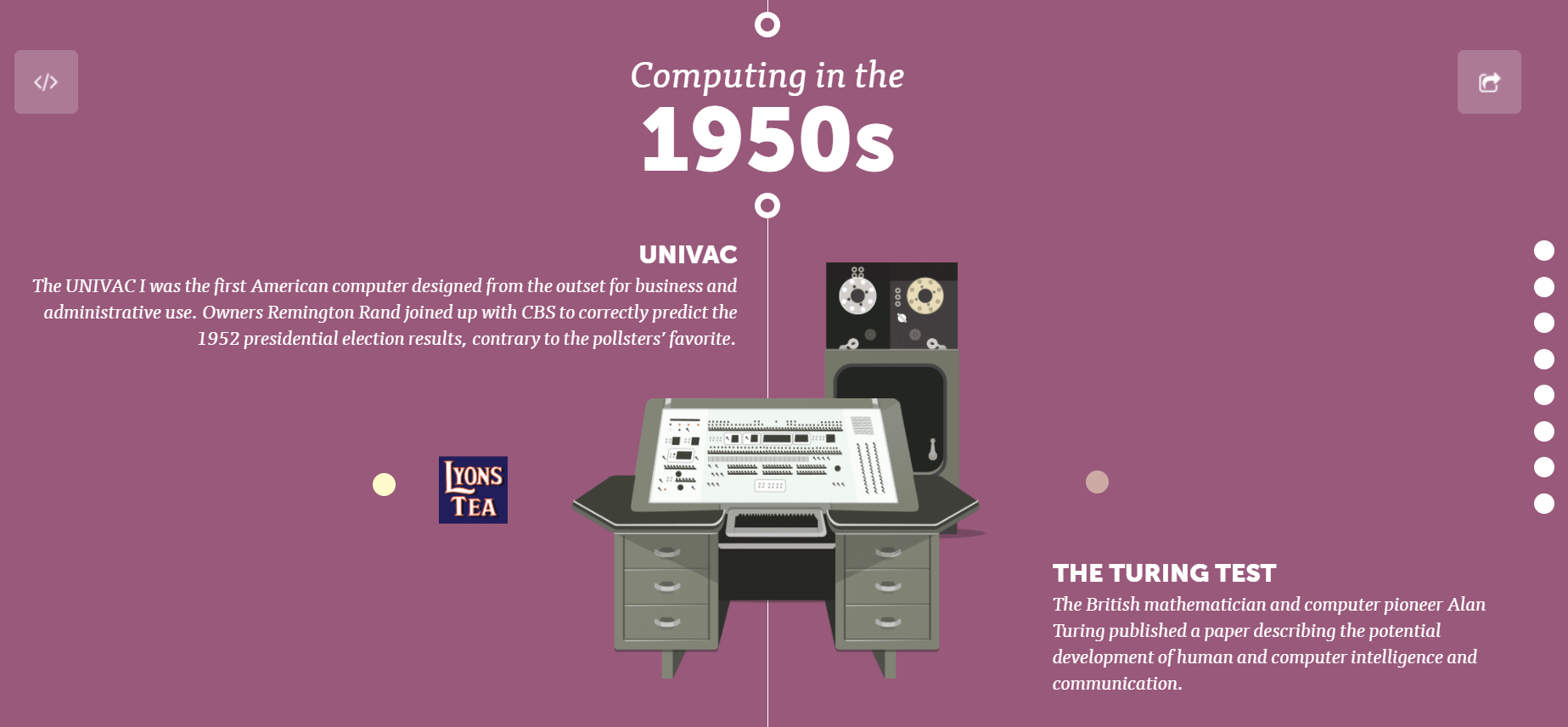
When you build your timeline, make sure you know which moments in history. If you’re creating a company roadmap, your timelines should focus on your heritage and critical points in your evolution. If you want to stand out as environmentally friendly, show all the biggest environmental initiatives you’ve been involved in. In other words, focus on what matters most to your target audience, whether it’s customers, investors, or potential employees.
11. Graphs and Charts
Interactive marketing is often effective because it presents information in an engaging way. One area where it’s particularly useful to spice up your information is graphs and charts. If you’ve ever seen a graph or chart that’s so full of information it becomes difficult to read, you’ll know how valuable interactivity can be.
Interactive charts and graphs can help you highlight what’s important in easy, digestible chunks. They also give your audience the option to drill down into deeper details by clicking on a link or hovering over something.
The Pew Research Center’s data visualization of The Next America by Paul Taylor includes quite a few interesting examples of interactive demographic graphs and charts. The image below is taken from an interactive chart that shows the size of the US population by age group from 1950 to 2060. You can toggle the years and see the population composition change accordingly.
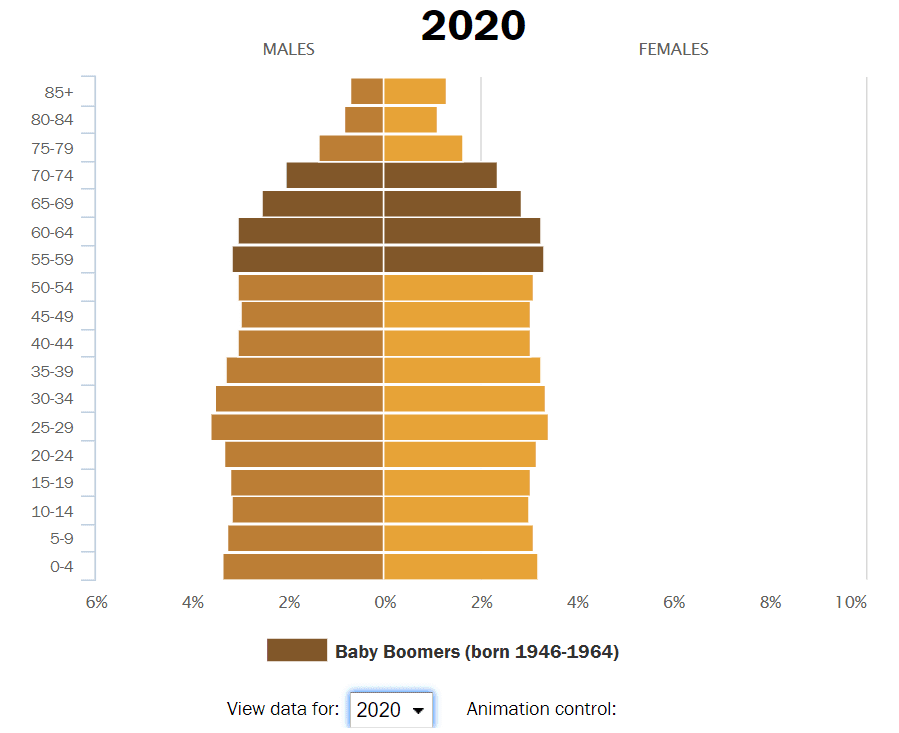
In any business, data visualization is extremely powerful. However, the best tools will only show the minimum amount of information at first glance. Let your audience decide which concepts they want to learn more about. After all, flooding a client with too much information can be overwhelming. Interactive graphs and charts put your audience in the driver’s seat.
12. Games (Gamification)
We all like having a little fun from time to time – even if it’s in the middle of a shopping trip or checking out a company’s website. Gamification is another form of interactive marketing that you can add to your site to make it more appealing. Taking a playful approach to knowledge sharing has proven effective in multiple fields, from education to habit building and brand awareness development.
This gamified chart by Setosa explains why buses bunch together by letting you influence their schedule. Participating makes the learning easier, more interesting, and more memorable.
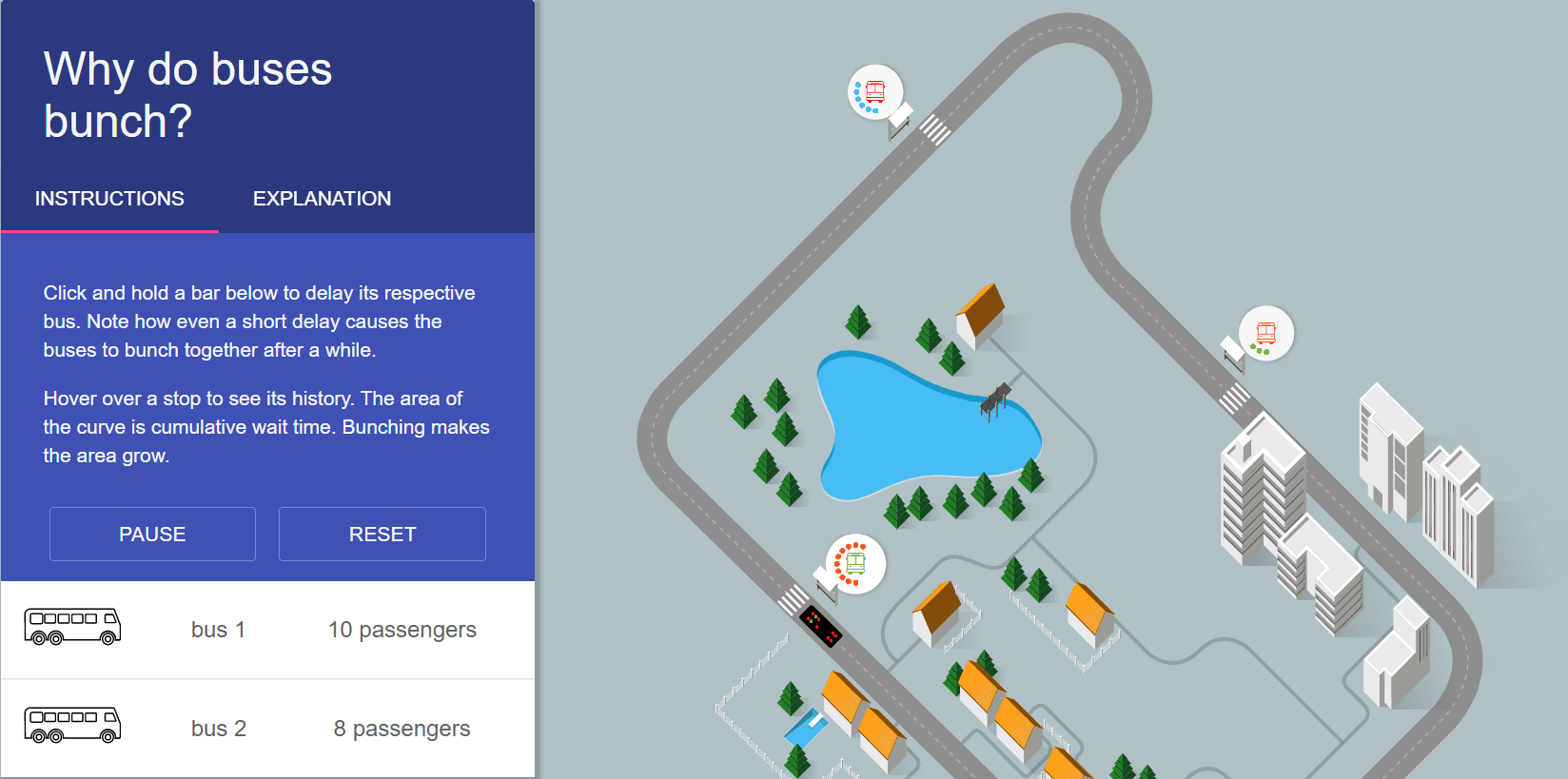
Games are captivating both cognitively and emotionally. They stimulate our need to compete, succeed and prove ourselves to ourselves and to others.
You don’t need to be a gamer or game developer to use gamification in your marketing strategy. You could, for example, easily build contests using online trivia quizzes that are both fun and informative. Here are some quiz templates that can help you get started. This is a great way to get your audience’s attention, connect with them, and give them a memorable experience they’ll enjoy. They may also share it, giving you the opportunity to enjoy some user-generated content. It’s also an excellent way to generate leads.
13. Wheel of Fortune
Wheel of fortune apps, like Wheelio, are another example of gamification that’s becoming increasingly popular on eCommerce sites. Their add ons invite users to spin a wheel for a prize in exchange for their email addresses.
It’s a gamified lead form. The retailer gets a new lead to add to their email list, and the customer gets the chance to win free shipping or a discount code for their purchase.
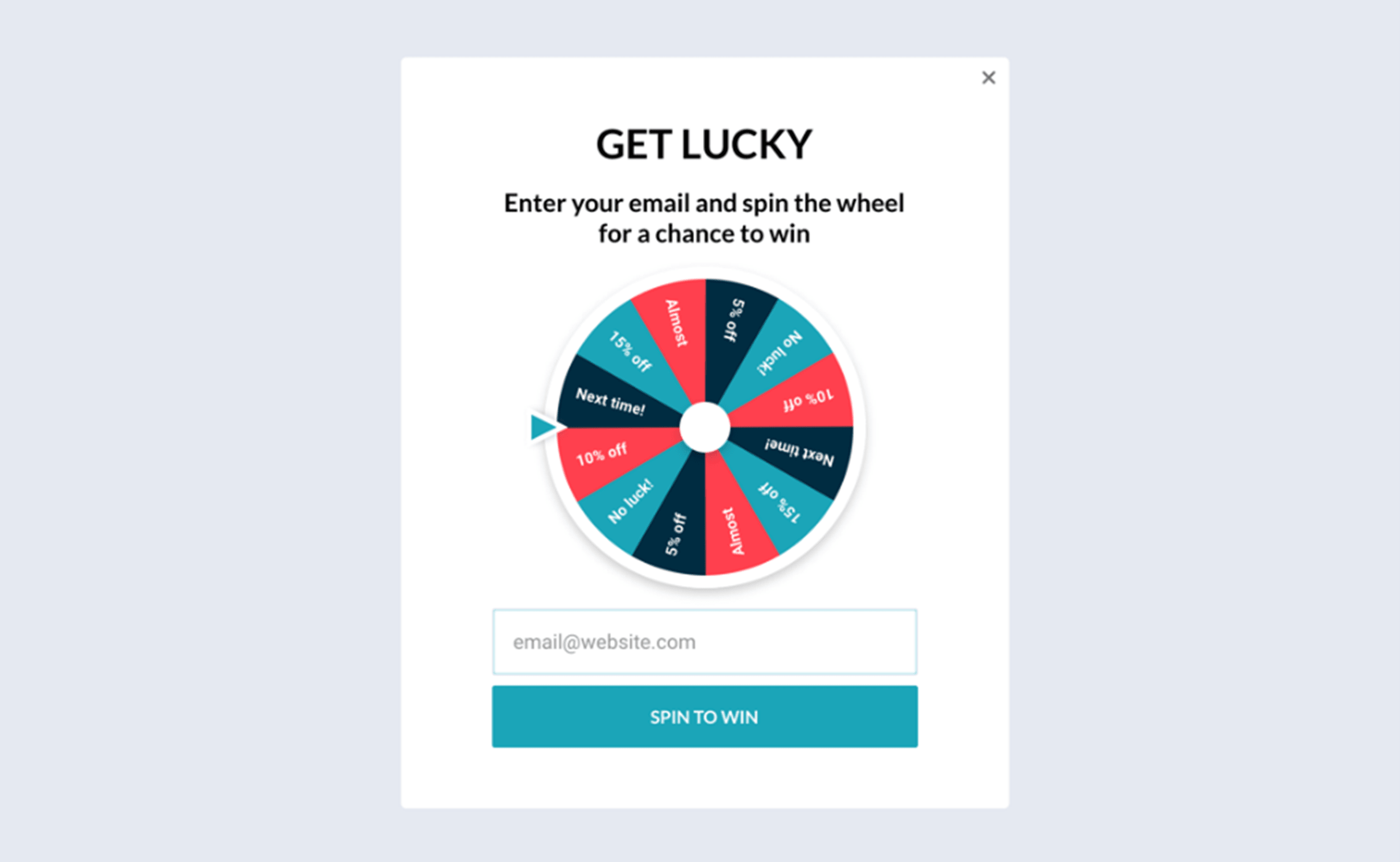
Adding fun and games to your marketing strategy doesn’t just boost engagement; it has a positive impact on your brand image too. You show your customers that you have a friendly, human side. That’s the kind of thing that inspires repeat purchases later.
14. Product Finders
Interactive marketing tools serve a variety of purposes, depending on how you use them.
Quizzes, surveys, and gamification elements entertain your audience. They give them a reason to spend more time on your website and interact with your brand. Interactive blogs and articles allow users to control their education. As a result, customers get to choose how much information they get about different topics.
In some cases, interactive pieces of content can also be an excellent way to simplify the purchasing journey for your customer.
For instance, you could use a product recommendation quiz to help your customer decide what they should buy. Product finders come in different formats, but in general, they ask your customers what they need, and generate a list of suitable products based on their reply.
Here’s a live example you can try:
Product finders are as close as you can get to personally guiding our customers through the online purchase. They work for everything from eCommerce stores, to SaaS providers and even agencies.
15. Countdown Timers
Countdown timers are not only for races and contests. They have started to grow in popularity among marketing experts since the rise of concepts like FOMO (Fear of Missing Out). Today’s customers are interested in saving money. They want to feel like they’re taking advantage of all the best deals and opportunities out there. Putting a clock or timer on your website adds a sense of urgency to your deal.
With an interactive timer that changes every time a user logs onto a web page, you constantly push your audience towards a purchase. The sense of urgency grows with every tick.

The key to success with these interactive time-sensitive formats is ensuring that the experience is authentic for your audience. Once the countdown ends, your customers won’t expect to see it starting up again the next time they visit your website. In other words, show commitment if you wish to create loyalty. And follow through on your threat to take the offer off the table. Used correctly, countdowns can help you create a buzz about your brand too.
These kinds of time-sensitive experiences are brilliant for generating more engagement between your audience and company.
16. Slideshows
Slideshows are an excellent way to guide your audience through a story or narrative, without relying on video. They are a versatile tool for sharing information and insights. You can design flipbooks that make it feel as though your audience is flicking through the pages of a real-life magazine. Alternatively, you might create an interactive slideshow with animated elements on every page.
Some companies use slide shows to make their company reports more engaging. Others use them as a learning tool. You could even combine slideshows with trivia quizzes and other interactive practices to create an online webinar. If you’re not ready to go live, you can also use pre-recorded webinar platforms to build engaging experiences that run on your schedule while still keeping viewers actively involved.
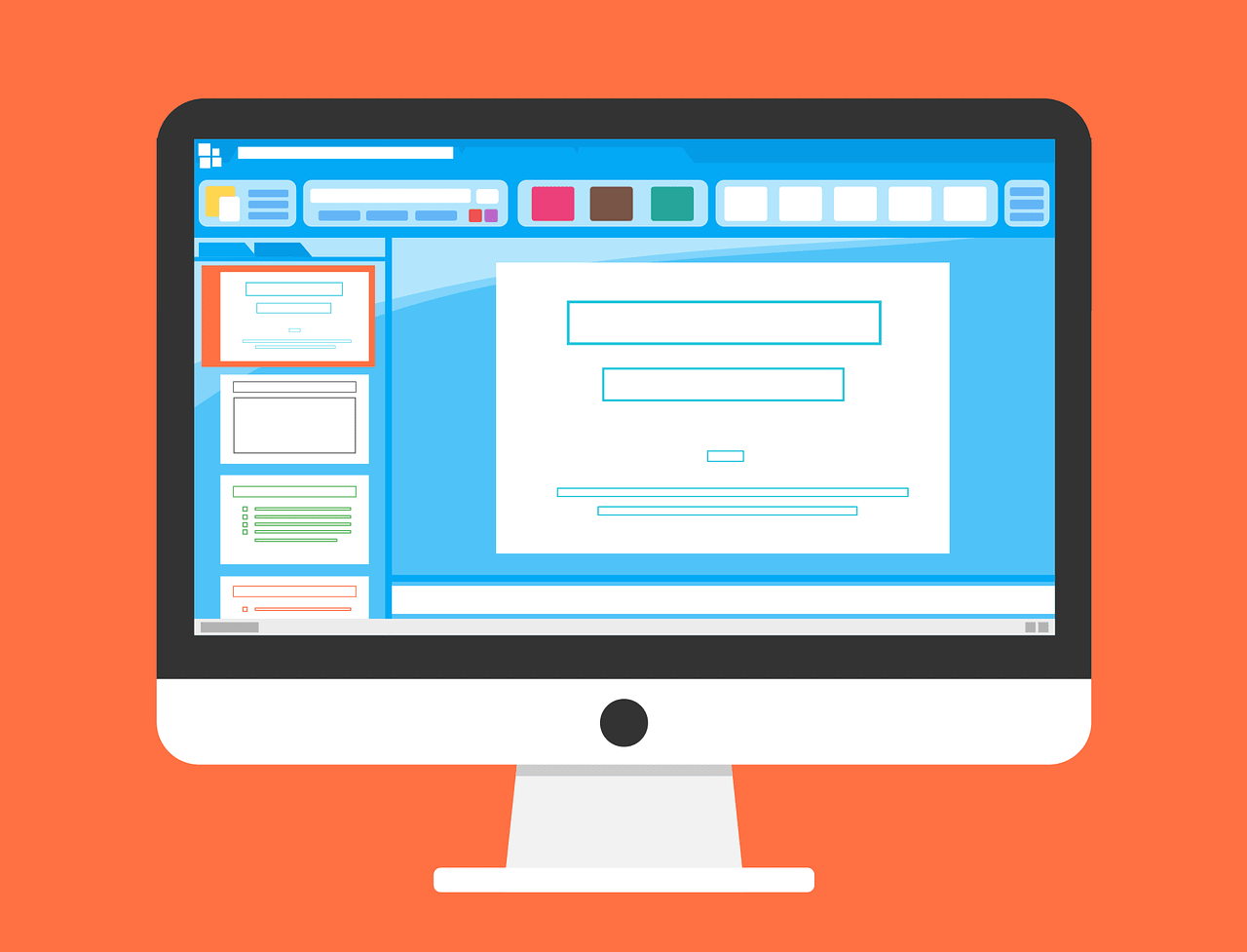
The key to success with slideshows is the same as with any valuable marketing effort. Whatever topic you’re covering, make sure that you’re providing information that makes your customers want to carry on clicking.
Slideshows also work best when there’s more visual information than written text. So use a lot of photos, illustrations, and videos. Just make sure you don’t overwhelm your audience with details, or your slideshow will start to feel like an interactive whitepaper or eBook instead.
17. Interactive Forms
Interactive forms are a valuable lead generation tool for any website. They’re the solutions that companies use to build an email list for lead nurturing. Forms also help customers to request quotes for services, or book appointments with professionals.
Although some forms can be a little boring and annoying to fill out, they’re a crucial part of the client-provider relationship. They’re often a gateway to successful email marketing since they’re used to collect email subscribers. With the right form, you can avoid the annoyance and even increase the chances of customers becoming dedicated members of your community as well as advocates for your brand.
The important thing to remember when designing forms for your website is that they need to be as simple as possible. Focus on user experience. In other words, don’t ask for too much too fast. Too many questions at once could easily scare a customer away if they’re not comfortable with your brand yet.
A common example of a useful interactive form on your website is the “Get a Quote” option. Since pricing is one of the first things your customers will need to look at when deciding which companies to work with, a quote form is a handy tool.
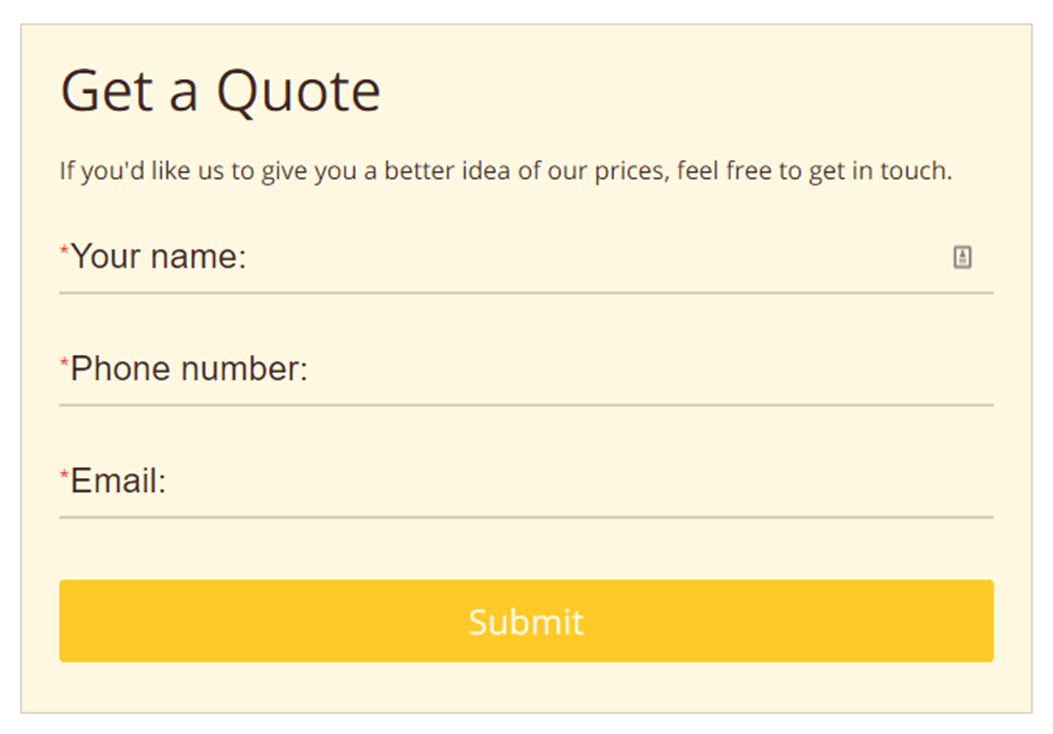
Of course, there are plenty of other types of forms you can consider too. For example, you might look into booking forms or forms that allow your customers to sign up for your newsletter. An email sign-up form is great for nurturing that reader who might not be ready to become a buyer straight away. Forms on the bottom of interactive blogs can also keep your readers coming back for more. Here are some form templates that can help you find the right type of form for your interactive marketing campaign.
Making the Most of Interactive Content
There are many interactive marketing methods to choose from. We hope these examples of interactive content got your creative juices flowing. Interactive marketing is a brilliant way to connect with your prospects and give them an immersive experience online. Whether you’re experimenting with interactive blogs or focusing on your social media platforms, you’ll have endless opportunities to delight your customers throughout the customer journey.
In summary, it’s more than just a way to fill your website. Interactive content gives you the right tools to strengthen your bond with your target audience and outshine the competition. If you haven’t started to experiment with it yet, now could be the perfect time to begin.

